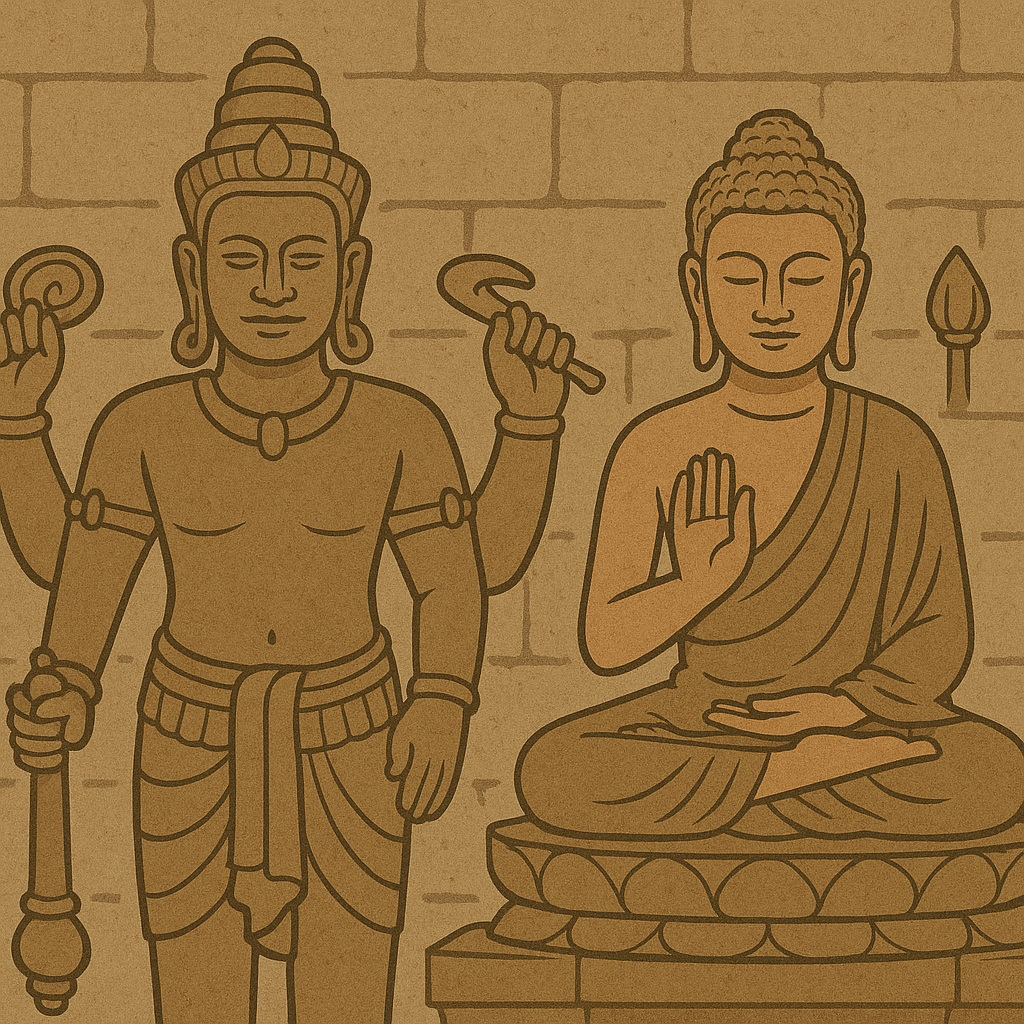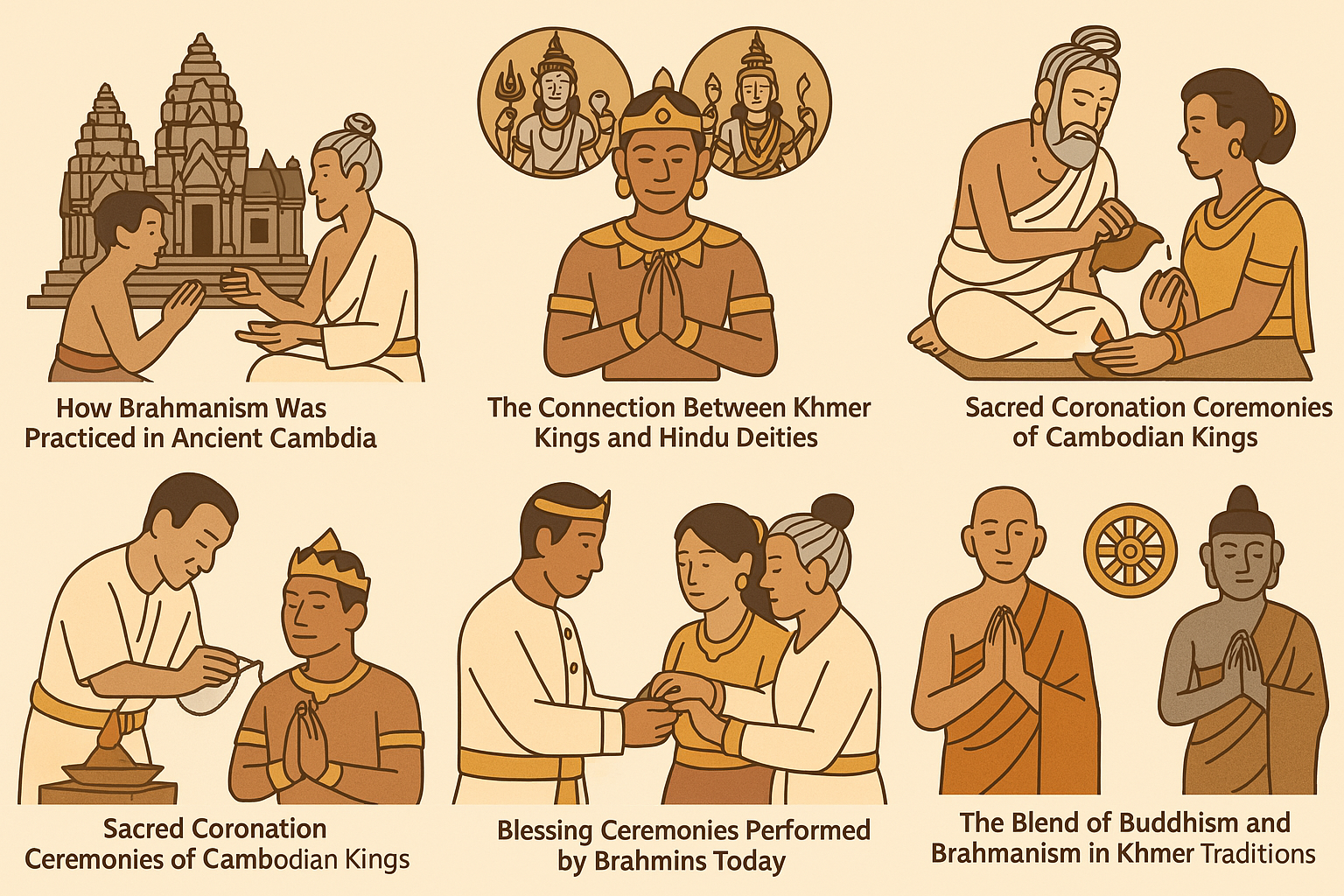Exploring the Sacred Legacy of Hinduism in Khmer Civilization
Cambodia’s rich spiritual heritage is often associated with Theravāda Buddhism, which remains the country’s dominant religion today. However, peel back the layers of history, and you’ll find that ancient Cambodia was once a vibrant cradle of Hindu belief. From majestic temples to mythological carvings, the Hindu influence in ancient Khmer civilization left an enduring mark on Cambodian culture, architecture, and traditions. This article explores the profound legacy of Hinduism in Cambodia, revealing its deities, symbolism, cosmology, and cultural continuity.
Hindu Deities Worshipped in Ancient Khmer Temples

Long before Buddhism became prevalent in Cambodia, Hinduism shaped the spiritual landscape of the Khmer Empire. Indian merchants and Brahmin priests introduced Hindu beliefs as early as the Funan period (1st–6th centuries CE), and these ideas blossomed during the height of the Khmer Empire (9th–15th centuries).
The temples of Angkor are home to countless sculptures and inscriptions honoring the major Hindu trinity:
- Vishnu, the Preserver, was especially revered. Angkor Wat itself—Cambodia’s crown jewel—was originally built as a temple to Vishnu by King Suryavarman II in the 12th century.
- Shiva, the Destroyer and Regenerator, was also widely worshipped. Temples like Baksei Chamkrong and Phnom Bakheng contain prominent lingams (phallic symbols representing Shiva’s cosmic energy).
- Brahma, the Creator, though less commonly worshipped directly, still appears in carvings and religious iconography.
These deities were not just abstract ideas—they were viewed as divine rulers, patrons of kingship, and guardians of the kingdom’s prosperity.
The Concept of Mount Meru in Khmer Temple Architecture

Central to Hindu cosmology is Mount Meru, the mythical axis of the universe, believed to be the home of the gods. This concept became the blueprint for Khmer temple design.
Temples like Angkor Wat, Bakong, and Pre Rup were constructed to symbolize Mount Meru. The typical layout featured a central tower (prasat) surrounded by four smaller towers, representing the five peaks of Mount Meru. The encircling moats and galleries symbolized the cosmic ocean and mountain ranges.
Khmer architects didn’t merely build places of worship—they recreated the universe in stone, embedding spiritual geography into their sacred spaces.
Vishnu, Shiva, and Brahma in Khmer Religious Iconography

Khmer religious art integrated Indian deities with a distinctly local aesthetic. Hindu gods appear in serene or dynamic poses, carved into lintels, pediments, and gallery walls.
- Vishnu is often depicted reclining on the serpent Ananta, floating upon the cosmic ocean. His avatars—especially Rama and Krishna—frequently appear in temple carvings.
- Shiva is shown as a yogi or in his cosmic dance form (Nataraja), surrounded by flames, symbolizing destruction and creation. His sacred bull, Nandi, often guards the temple entrances.
- Brahma, with his four faces, is portrayed as the wise creator, though he is more symbolic in Khmer art than physically worshipped.
These visual representations served not only religious purposes but also reinforced the king’s divine right to rule.
Hindu Mythology in Khmer Carvings and Bas-Reliefs

Perhaps the most visually stunning evidence of Hindu influence is the elaborate bas-reliefs and carvings on temple walls. These artworks are visual retellings of sacred Hindu epics like the Ramayana (Khmer: Reamker) and the Mahabharata.
At Angkor Wat, you’ll find:
- The Churning of the Ocean of Milk, a cosmic story where gods and demons churn the sea to obtain the nectar of immortality, with Vishnu in the center.
- Battle scenes from the Mahabharata, emphasizing heroism, dharma (righteousness), and cosmic order.
- Episodes from the Reamker, Cambodia’s own rendition of the Ramayana, featuring Hanuman, the monkey god, and Sovann Maccha, the golden mermaid unique to Khmer folklore.
These narratives weren’t mere decoration—they served to educate, inspire, and assert divine legitimacy of the Khmer kings.
The Transformation from Hinduism to Buddhism in Khmer History

From the 13th century onward, Cambodia saw a gradual shift from Hinduism to Theravāda Buddhism, a transformation influenced by regional dynamics and changing royal preferences. While early Khmer rulers adopted Hinduism, later kings like Jayavarman VII embraced Mahāyāna and eventually Theravāda Buddhism.
However, the transition was not abrupt or destructive. Instead, it was syncretic—Hindu and Buddhist iconography coexisted, and many temples were simply repurposed. For example:
- Angkor Wat, initially a Vishnu temple, later became a Buddhist sanctuary.
- Hindu deities continued to be revered alongside Buddhist imagery in art and ritual.
This peaceful blending of religions allowed Hindu concepts to permeate Cambodian culture long after formal worship waned.
Hindu Rituals and Their Remnants in Modern Cambodian Traditions

Even today, traces of ancient Hindu rituals persist in Cambodian customs, particularly in royal ceremonies and village traditions:
- Brahmins still play roles in royal events, such as coronations and agricultural rites like the Royal Ploughing Ceremony.
- The thread-tying ceremony for blessings and protection has roots in Hindu practice.
- The use of holy water, incense offerings, and astrological charts in Khmer weddings and funerals echoes Vedic ritualism.
These surviving elements are testaments to the long-lasting imprint of Hinduism on Cambodia’s cultural fabric.
The Influence of Hindu Astrology and Cosmology in Cambodia

Hindu cosmological ideas shaped not only architecture but also Khmer conceptions of time, fate, and kingship:
- Ancient Khmer temples were aligned with astronomical events, such as solstices and equinoxes, reflecting Hindu cosmological principles.
- Astrology (Hora Shastra) still plays a significant role in Cambodia. Many Cambodians consult astrologers for auspicious wedding dates, business ventures, and health matters.
- The lunar calendar, used for festivals and ceremonies, has its roots in Indian timekeeping systems.
This cosmological framework was woven into the governance, architecture, and daily life of the Khmer Empire—and continues to guide spiritual life in Cambodia today.
Conclusion: A Sacred Legacy That Lives On
The Hindu influence in ancient Cambodia is more than a chapter in history—it’s a living legacy. Though Buddhism has become the dominant spiritual force, Hindu philosophy, art, and ritual remain embedded in the nation’s soul. Walk through the ruins of Angkor, and you walk through a stone manuscript of ancient India interpreted through Khmer eyes.
From cosmic temples mirroring Mount Meru to enduring ceremonies rooted in Vedic rituals, Hinduism helped shape the identity of ancient Cambodia—and its echoes still resonate through modern Cambodian culture.




